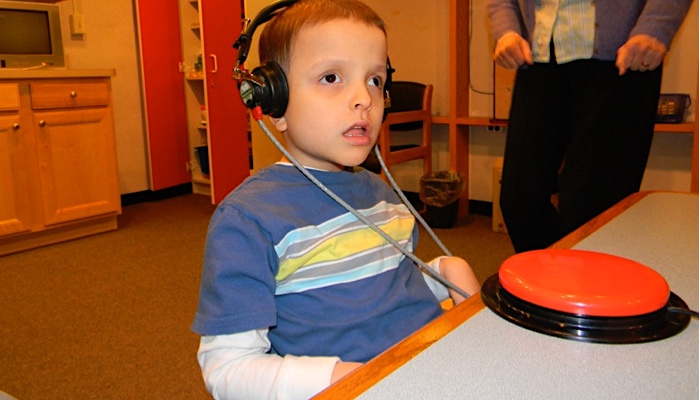A Visit to Audiology

Kids with vision impairments rely on their hearing so much that it’s a good idea to regularly visit an audiologist just to make sure everything is working right.
But if your child is nonverbal and cognitively delayed, how can you administer a hearing test? How does the audiologist check your child’s hearing if they can’t tell you what they’ve heard?
It’s not an easy task, but it can be done with a reasonable amount of accuracy. Between physical testing and lots of observation, you and your audiologist will be able to tell if your child is hearing within a normal range or not. And that is valuable information indeed!
The Hearing Test
Do you remember taking hearing tests when you were a kid? I remember wearing headphones, listening for beeps, and raising my hand when I heard something. Pretty simple, right?
For kids with multiple disabilities this can be a real challenge, but there are still ways to judge how well they are hearing.
Audiologists can try to have your child wear headphones and see how they respond when they play sounds. Another technique may be to play music through the headphones then suddenly stop. Does your child react to the sudden loss of music? Will they ask for more?
If headphones are out of the question (and that’s not unusual at all), then the audiologist may use large speakers instead, one placed to the right of your child and one to the left. In a sound-proof room, sounds coming from specific locations can be very powerful.
Again, it’s a game of observation. How does your child react to the sounds? Does he lean toward the speakers, get real quite, smile… cry? Either way it means he can hear the sounds and that’s a good thing.
Here is a video of Ivan listening to funny sounds on the speakers. It’s hard to see in the video, but he turns toward the sounds coming out of the right then left speakers:
The Otoacoustic Emissions Test
An Otoacoustic Emissions Test (OAE) is a physical test that doesn’t rely on your child’s response. In fact, it’s probably better to do the OAE while your child is asleep or even sedated so as to avoid background noises and movement.
An OEA is done by placing small ear plugs in your child’s ears connected to wires. The ear plugs send sounds into the ears and picks up the vibrations resulting from normal movements in the middle ear. If theses vibrations are within normal range, then hearing should also be normal.
This is also a good test to repeat because once you have a baseline for your child you can monitor any changes in their OEA which may indicate hearing issues.
The Auditory Evoked Response
Another test you may want to consider is the Auditory Evoked Response, or AER. This is actually a type of EEG that measures the brain’s response to sound stimuli. It’s much more invasive than a simple hearing test or OAE because it requires EEG leads to be glued or taped to your child’s head, and in my experience, kids aren’t too wild about this!
The AER won’t tell you if your child can hear or not because the test doesn’t look at the ears themselves. What the AER measures is the brain’s ability to process sounds. If your child has a known neurological condition or experiences seizures, this test may be a good idea. You’d want to talk to your neurologist about ordering an AER.
There are many other tests an audiologist may want to try with your child, but these are a few basics. Remember that even if you think your child’s ears are fine it’s still a really good idea to have them checked at least annually.
Related Posts

Communication, Health & Nutrition
Recurrent Ear Infections and Their Impact on Speech/Language Development
Learn more about the relationship between recurrent ear infections and their potential effect on speech and language development.

Communication, Potty Training
How to Use Sign Language for Potty Training
Sign language can be helpful for potty training young children who are pre-verbal, kids with special needs, or for multilingual families.

Communication, Visual Impairment
Teaching Your Visually Impaired Child Sign Language
Jennie writes about how she taught her son, Max, to sign. Max is totally blind and does have a few verbal words, but using signs to augment his early communication...